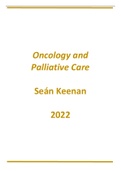Summary
Summary Oncology and Palliative Medicine
- Course
- Institution
oncology and palliative medicine notes detailing all common oncological pathologies and conditions across all bodily systems for medical school exams, including palliative care medicine. Notes made from multiple resources such as oxford handbook, question banks, university lectures and UK guideline...
[Show more]



